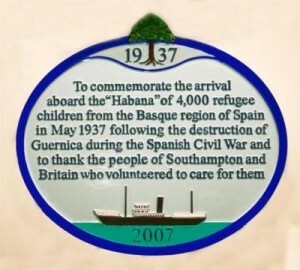Los Niños de Guernica
Gillian Darley
In Southampton last week, a city I am completely unfamiliar with, I noticed at the entrance to the City Art Gallery an attractive blue roundel. Bearing the date 2007 it commemorated, seventy years after the event, the arrival of almost 4000 refugee children, with a small support team of teachers, priests and volunteers, from Guernica.
The story of the Kindertransport is well known, but this prior episode in late May 1937 seems to have faded from general memory. I looked it up on a BBC local history webpage and the Basque Children of ’37 Association website. The story involves a prevaricating government, a persuasive Archbishop of Canterbury, a tireless Salvation Army and the support of every left-leaning, Republican-sympathising individual and organisation in Britain, particularly the trade unions, as well as the Catholic church. The British navy provided an escort, taking over from a Spanish destroyer as soon as the Habana was safely away from Bilbao in international waters.
The evening after I’d seen the plaque, I came across a photograph of two laughing little girls in a new book about the remarkable 1930s photographer Helen Muspratt. She had found them at the refugee camp established for the children, thanks to a generous farmer, on fields at North Stoneham, just outside Southampton. Muspratt had been on the dockside when the Habana docked. The elderly steamer had berths for many fewer passengers than the more than 3800 on board, and press photographs showed the decks packed with children.
They were moved on as quickly as was practicable, and by the early autumn they had all been relocated. Depending on their age and family circumstances (many were orphaned) they were repatriated to Spain (Franco having by then secured the Basque country), to other European countries or to the USSR. Around four hundred stayed in Britain and many of them never left.

Comments
Although it doesn't have the cultural resonance of the Kindertransport, the story of the niños vascos does crop up from time to time in public discourse as well as academic writing. (I mention it to my students.) A photo of the Habana appears in this Washington Post piece from last September, and in all sorts of other places on the internet:
https://www.washingtonpost.com/news/morning-mix/wp/2015/09/11/great-uprootings-the-photographs-of-the-worlds-most-massive-migrations/
...and you come across news stories from time to time, especially at anniversaries, like this one from a few years ago:
http://www.theguardian.com/society/2012/mar/25/basque-children-civil-war-refugees-reunion
Some images of the camp at North Stoneham can be viewed on the website of the Modern Records Centre at Warwick University:
http://www2.warwick.ac.uk/services/library/mrc/explorefurther/digital/scw/more/northstoneham
I knew two of those Basque children (and several adults too) who fled to England and became teachers at Dartington School near Totnes in Devon. The two children were Carito and Marina Rodriguez -- Carito is now dead but I believe Marina still lives in Totnes. Some years ago there was a TV programme called "Only Three Months" about this exodus -- so-named because they expected to be away from Spain only that time, but many never saw their parents again. The two I knew did go back to Spain on visits but returned to live in England.
I forget details of the TV programme but maybe someone else remembers it!
Harriet Ward
Along with many others I knew Marina as housemother of 'Red and Yellow' at Foxhole (Dartington Hall School) and Carito as a teacher at Aller Park (also part of Dartington Hall School)
I know the photograph in Jessica Sutcliffe's book (Jessica is a neighbour in Swanage) but had no idea it was Marina and Carito.
A lovely discovery.
Deborah Paige